
5 Most Common Shoulder Training Mistakes!
Shoulder injuries are one the most common areas that get injuried in the gym. Many bodybuilders and other athletes can develop shoulder problems through repetitive and intensive training routines. In most cases these injuries can be avoided by concentrating on your form, using lighter weights or just using better exercises.
Alot gym junkies have a tendency to ignore the pain and try to just work past it, but this is totally the wrong approach as this will only make things worse or even cause more problems. Here are a few of the most common mistakes to make sure you steer clear from.
Mistake #1:
Keeping Your Arm Straight Doing Lateral Raises
————————————————————————–
Lateral raises are designed to target the middle head of the deltoids and should be done with a slight bend in your elbow. The problem is most people don’t keep the elbow locked through the entire movement, but instead they have a 90-degree bend in the arm at the bottom of the movement and as they raise the arm their arms straightens to about 180 degrees. This is very common when doing working one arm at a time. When you straignten the arm during the movement you focus more on the triceps and the deltoids, making it more of an elbow extension rather then a raise. So remember keep your arms locked in position with your arm slightly bent.
Mistake #2:
Straightening Your Arm on Rear Delt Exercises
————————————————————————–
Again we have the same problem, this time on exercises for the rear deltoids. The most common exercise is the bent-over lateral raise using either dumbbells or cable machine. The most important thing to remember again is to lock your arms in a slightly bent position through the entire movement of the exercise otherwise you will end op working the triceps rather then the triceps. If your struggling try lowering the weight or practice reverse flyes on the peck deck machine.
Mistake #3:
Hands Are Too Close Together Doing Upright Rows
————————————————————————–
Upright rows are designed to target the middle deltoids, however when you have a close grip your elbows get drawn forward which causes your shoulder to get internally rotated. This type of movement is bad for your shoulder joints and can be avoided by holding the bar with a wider grip (hands about shoulder width apart is perfect), this allows you to flare your elbows out and keep your upper arms traveling at your sides working your middle deltoid and avoiding injury. Avoid using the close grip version and stay injury free.
Mistake #4:
Neglecting Your Rotator-Cuff Muscles
————————————————————————–
Building big shoulders means targeting the muscles from all angles with exercises that work the front, middle and rear deltoids. However, many people tend to forget about one of the smaller rotator cuff muscles that help stabalize the shoulder joint. Strengthen the rotator cuff muscles are very important, should you fail to train the muscle over time as your deltoids grow stronger a strength imbalance can occur which making you susceptible to injury or serious pain. Most rotator cuff exercises can be done with cables, bands or light dumbbells and will be worth it in the long run.
Mistake #5:
Lifting Heavy Weights On Behind-the-Neck Presses
————————————————————————–
Lifting heavy weights is certainly the way to go when training the shoulders, that’s the how you increase your strength. However, when you are lifting heavy weights for low reps it’s best to use presses where you lower the bar in front of you. Doing behind the neck presses cause’s the shoulders to be externally rotated which is one of the biggest cause’s of sport injuries. So loading up the bar with maximum weight is only going to increase your risk of injury. So just remember next time your training shoulders stick to moderate weights for behine-the-neck-presses.
Remember you should always train smart first, then train hard. You will be healthier, injury free with better gains.